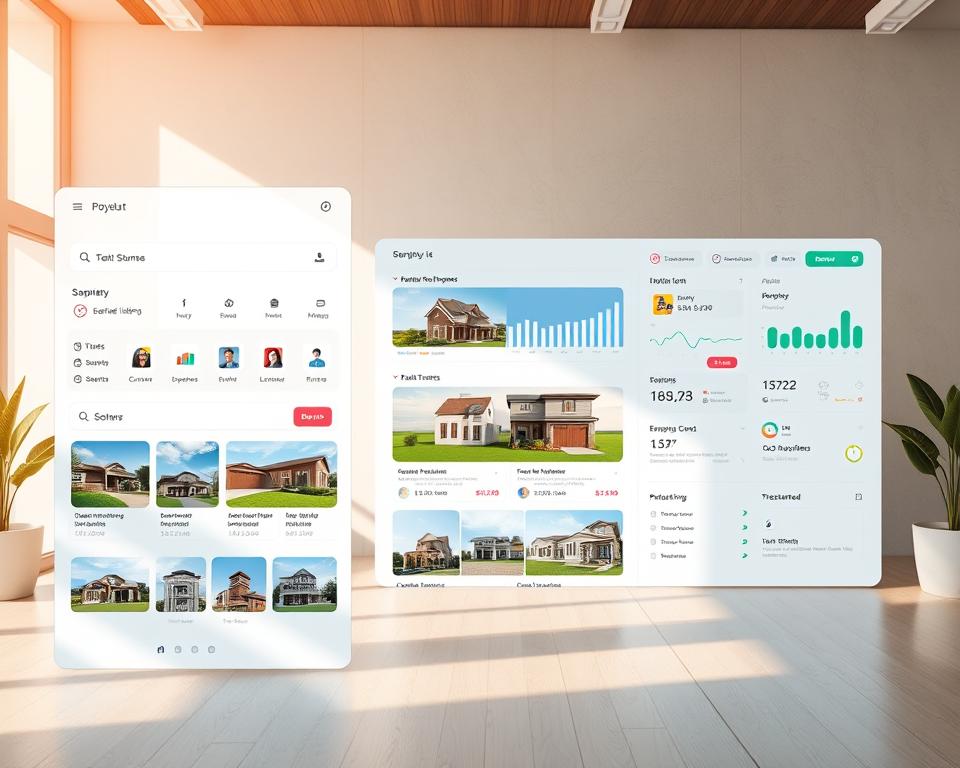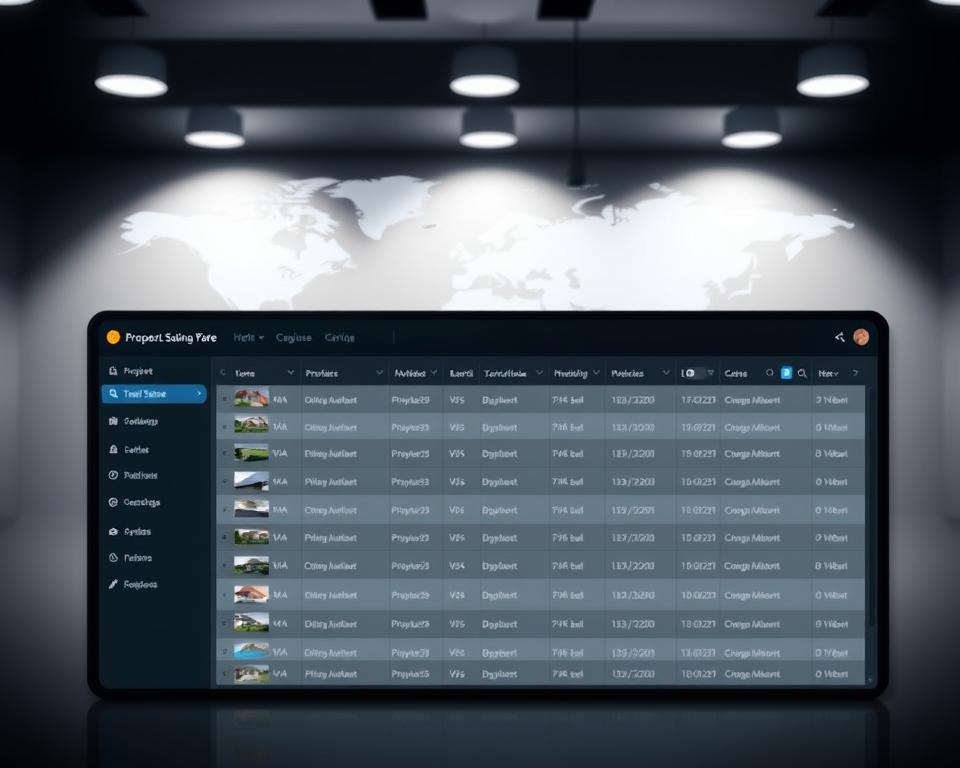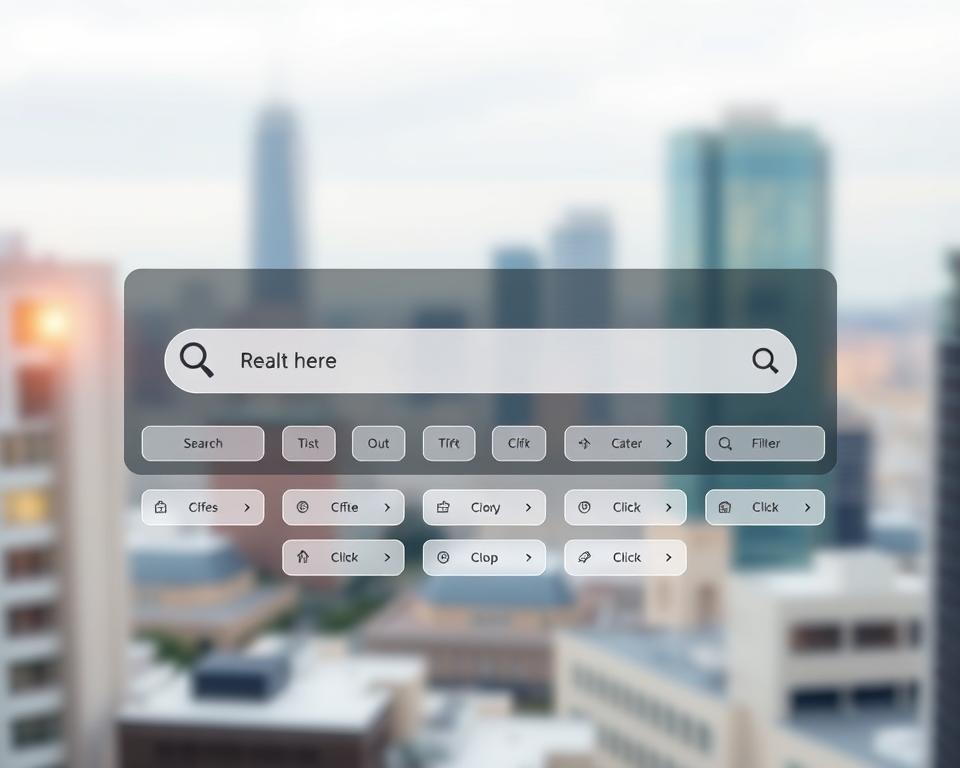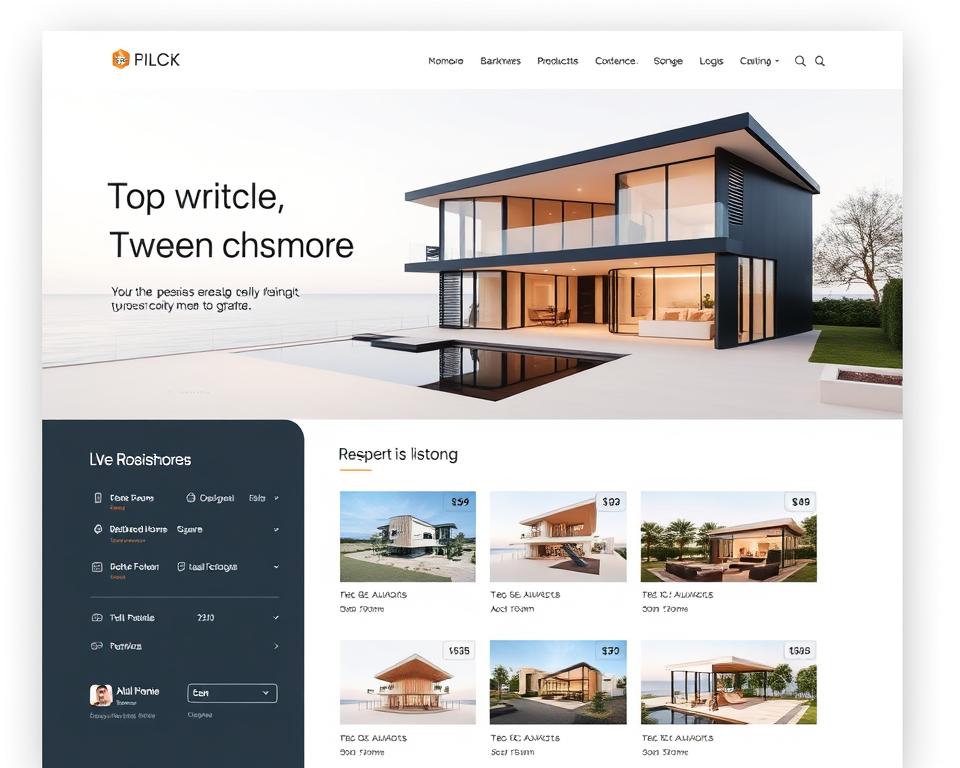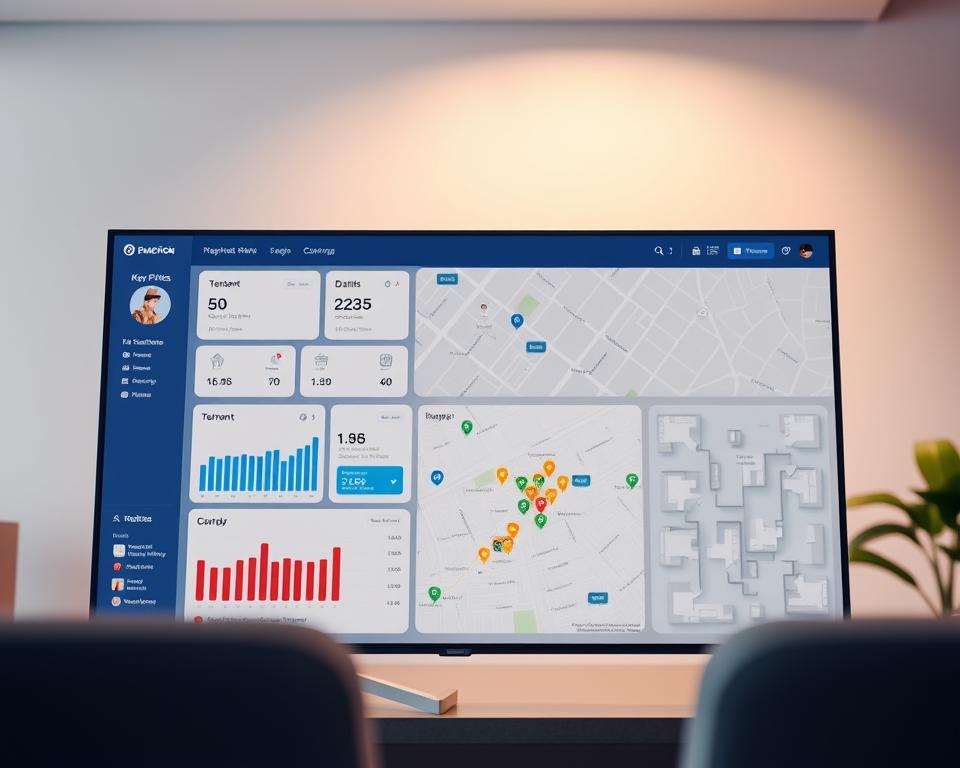To start a successful online real estate business, you need to know the market well. You must also create features that help buyers, sellers, and agents. A good real estate portal offers a smooth user experience, advanced search, and useful resources.
In the U.S., more people are using sites like Zillow and Realtor.com. They look for homes, check prices, and find real estate pros.
Building a real estate portal is a big task. It needs careful planning, execution, and upkeep. Knowing the market size, key players, and gaps can help entrepreneurs succeed. This article will guide you through building a successful online real estate business.
Table of Contents
Introduction to Real Estate Portal Development
The field of real estate portal development is always changing. New tech and ideas come out every day. To keep up, understanding the market is key.
This includes knowing the market size, key players, and gaps. With this knowledge, businesses can make a portal that stands out. It meets the needs of its users and aims for long-term success.
Key Takeaways
- Real estate portal development requires a deep understanding of the market landscape
- Creating a seamless user experience is crucial for online real estate business success
- Advanced search functionality is a key feature of successful real estate portals
- Understanding the current market size and potential is essential for real estate portal development
- Key players analysis and market gaps and opportunities can help businesses create a unique value proposition
- Real estate portal development is a complex process that requires careful planning, execution, and ongoing maintenance
- Online real estate business can drive long-term success with the right strategy and execution
Understanding the Real Estate Portal Market Landscape
The real estate market is complex and always changing. Many players are vying for the top spot. To win, knowing the market size, potential, and key players is key. The real estate market landscape is shaped by big names like Zillow and Realtor.com, setting the bar for online services.
Some key traits of the real estate market include:
- More people want online real estate services
- More competition among players
- New tech and innovation
The size and potential of the real estate portal market are big. The global online real estate market is expected to grow. Understanding market gaps and opportunities is vital for innovation and standing out. By studying the market, we can create a unique real estate portal that serves buyers, sellers, and agents well.
Current Market Size and Potential
The real estate portal market is already big, with millions using online services daily. Its growth potential is huge, thanks to more demand and tech advancements.
Key Players Analysis
Big names like Zillow and Realtor.com lead the real estate portal market. They’ve set the benchmark for online services. Newcomers need to find their own way to stand out and compete.
Essential Features of Successful Real Estate Platforms
A top real estate platform needs several key features to keep users coming back. It must have a detailed property listing database that’s always up to date. This ensures the information is both accurate and relevant.
Some must-have real estate platform features include advanced search tools. These let users filter properties by location, price, and amenities. It’s also important to have a user-friendly interface. This makes it simple for users to find what they need.
- High-quality photos and virtual tours of properties
- Detailed property descriptions and information
- Agent and broker profiles, allowing users to connect with local experts
- Community forums and reviews, providing valuable insights and feedback
By adding these features, a real estate platform becomes a valuable tool for both buyers and sellers. It stands out from the competition and becomes a market leader. A well-designed property listing database is key. When combined with other essential real estate platform features, it boosts user engagement and conversion.
Technical Requirements for Building a Real Estate Portal
Creating a real estate portal requires careful planning. A good technology stack is key for a strong platform. You need to pick the right programming languages, frameworks, and databases.
A solid database architecture is also crucial. It helps manage lots of data like property listings and user info. You must plan well to keep data safe and growing.
Security and scalability are also important. You need strong security to protect user data. And the platform must handle lots of traffic and data. By focusing on these areas, developers can make a portal that meets user needs and stays competitive.
Creating Your Property Listing Database Structure
To create a top-notch real estate portal, you need a solid property listing database. This database will hold lots of real estate info, like property details, prices, and locations. A well-organized database is key for quick and precise search results, which keeps users coming back.
Think about adding fields like property type, size, and amenities. Also, indexing the data will make searches faster. This way, you’ll make a database that helps both buyers and sellers, offering a smooth experience.
Some important things to keep in mind when designing your database include:
- Data normalization to avoid data duplication and ensure data quality
- Indexing to speed up searches and cut down on wait time
- Data validation to keep the data accurate and consistent
- Scalability to handle more data as your site grows
A well-thought-out database structure is vital for your real estate portal’s success. By focusing on the right fields, indexing, and design principles, you’ll offer fast and accurate search results. This will boost user engagement and satisfaction.
Implementing Advanced Search and Filter Functionality
Users want a smooth and quick real estate search experience. To meet this need, advanced search features are key. These features help users find properties that fit their criteria fast. A good search algorithm considers location, price, and property type.
A top-notch real estate search site should have filters too. Options like property type, number of bedrooms and bathrooms, and square footage help narrow down searches. This way, users can find exactly what they’re looking for.
Geographic search tools are also vital. Features like map view and neighborhood search are essential. They let users see where properties are and what’s nearby.
Some important features of advanced search include:
- Search by location
- Filter by property type
- Sort by price or date listed
- Map view and neighborhood search
User Interface and Experience Design Elements
A good user interface is key for a real estate website. It makes it easy for users to find properties. The design principles help make it user-friendly. A great website has clear navigation, simple search, and clear calls-to-action.
Designing a user-friendly interface involves several things:
- Easy-to-use search functionality
- Clear and concise property listings
- Relevant calls-to-action
- Mobile-friendly design
A positive user experience is also vital. It boosts user engagement and sales. A well-designed website lets users easily explore properties. By focusing on user interface and user experience, a website can stand out in the market.
For instance, a website can have a simple search function. This lets users find properties easily. It can also have high-quality images and virtual tours for a detailed experience. By prioritizing user experience and user interface, a website can offer a great experience. This leads to more conversions and sales.
Building the Property Management System
A good property management system is key for real estate platforms. It lets users manage their properties well. This system should work smoothly with the real estate software.
When making a property management system, think about what features users need most. A user-friendly interface for listing creation and management is important. This includes automated updates, customizable templates, and easy syndication to other portals.
A user dashboard is also vital. It gives users a place to manage their properties, track listings, and see how they’re doing.
Streamlining Property Management
Using a property management system helps real estate pros work better. They spend less time on paperwork and more on important tasks like client relationships. The system should also help agents manage their work, keeping everything secure and efficient.
Choosing the right real estate software is important. Look at the property management system’s features and how it fits with your platform. A well-made system improves user experience, boosts efficiency, and grows your business. Focus on building a strong property management system to stand out in the market.
Integration of Maps and Location Services
When building a real estate portal, maps integration is key. It lets users see where properties are, making it easier to find homes. They can also filter by landmarks like schools and hospitals.
Real estate mapping gives insights into local markets and property values. For example, maps show where properties are, highlighting top neighborhoods. This info is great for buyers, sellers, and agents.
To use maps integration and location services well, pick the right tools. Google Maps, OpenStreetMap, and Mapbox are popular choices. They offer APIs and libraries for easy integration into real estate portals.
Adding real estate mapping and location services makes portals more engaging. It meets the needs of users, driving more traffic and boosting revenue.
How to Build a Real Estate Portal Like Zillow or Realtor.com: Step-by-Step Process
Creating a successful real estate portal needs careful planning and execution. It involves several key steps. To make a platform that helps both buyers and sellers, following a step-by-step guide is crucial.
The first step is planning. Here, you figure out who your users are, what features they need, and create a business plan. This phase is vital to ensure your portal is well-organized and useful for your audience.
Then comes the development phase. This is where you build your portal. You create an easy-to-use interface, a strong database, and add key features like property listings and search functions. A well-made portal makes it simple for users to find what they need.
The testing phase is also important. It checks if your portal works without problems. You test its functionality, performance, and security. By following a step-by-step guide and planning each phase carefully, you can build a successful real estate portal.
Monetization Strategies for Real Estate Platforms
Real estate platforms need to make money to succeed. They can do this by using different ways to earn, like premium listings, ads, and subscription plans. These methods help platforms make money while keeping users happy.
Premium listings are a big part of making money. They offer extra perks, like being seen more and having special features. Real estate agents and owners can partner to make their properties stand out more.
Using advertising models that fit the real estate world is also key. This includes ads from mortgage companies, home insurance, and more. These ads can be shown in a way that’s not too much for users but still helps the platform earn.
- Premium listings with advanced features
- Targeted advertising models from relevant businesses
- Subscription plans with exclusive benefits
By using these strategies, platforms can build a strong and profitable business. This leads to happier users, more engagement, and a successful platform.
Legal Compliance and Data Protection Measures
When creating a real estate portal like Kirby, real estate law and data protection are key. It’s vital to follow legal compliance to keep users’ trust and avoid legal problems.
A real estate portal must follow laws and rules, especially about data protection and privacy. This means using strong security like encryption and safe data storage. Also, a clear data protection policy should be made. It should explain how user data is handled.
Important points for legal compliance in real estate portals include:
- Following local and national real estate laws
- Using strong security to protect user data
- Creating a clear and open data protection policy
By focusing on legal compliance and data protection, real estate portals can offer a safe and reliable space for users. This can lead to business success.
Marketing and User Acquisition Strategies
Getting people to visit and stay on a real estate website is key. You need a mix of SEO optimization, content marketing, and social media. This way, your site can show up better in search results, bringing in more visitors. For tips on making a real estate app, check out this guide.
Having a good plan for getting users is crucial. You can use ads, emails, and social media to draw people in. Here are some ways to get more users:
- Make content that grabs and keeps people’s attention
- Use social media to promote your site
- Give users something in return for signing up
By using these methods and focusing on SEO optimization, your site can become more visible and trusted. This leads to more visitors and potential customers. Good marketing and user strategies are vital for a real estate site’s success. By using these approaches, you can outdo your competitors.
Mobile App Development Considerations
Creating a real estate portal involves mobile app development. It’s key to make sure users have a smooth experience. The aim is to build real estate apps that work on both iOS and Android platforms. This way, users can use the portal on their favorite device.
It’s important to think about what each platform needs. For example, iOS development means following Apple’s rules closely. On the other hand, Android platform integration needs to be flexible to fit different devices and screen sizes.
Some important things to consider in mobile app development are:
- Native app development for iOS and Android
- Cross-platform solutions for easier development
- Improving app performance for a better user experience
By carefully looking at these points and picking the best method, real estate portals can make great
Performance Optimization and Scaling
For a real estate website to be fast and efficient, performance optimization is key. This means looking at server setup, database tweaks, and caching. With these optimized, a site can handle lots of traffic and data. This lets users find what they need quickly.
To dive deeper into making a real estate portal, check out this resource. It breaks down costs and features for you.
Scaling is also vital. It’s about planning for the site’s growth. This might mean using cloud hosting and load balancing. These steps help the site handle more traffic smoothly.
By focusing on real estate website performance, developers make a site that’s both fast and reliable. This leads to a better user experience and boosts business success.
Here are some ways to boost performance:
- Optimizing images and media to reduce file size
- Minimizing HTTP requests to reduce load times
- Using caching to store frequently accessed data
Analytics and Reporting Features Implementation
Adding analytics and reporting features is key to understanding user behavior and market trends in real estate portals. Portal owners can learn a lot about how users interact with their site. This helps them find areas to improve and make better plans. Reporting tools track important metrics like property views, search queries, and user engagement.
Tracking user behavior is crucial. It lets portal owners know what their audience likes and does. This info helps create better experiences for users, making them happier and helping the business grow. Some important parts of tracking user behavior include:
- Watching how users navigate and search
- Looking at property views and engagement
- Tracking user feedback and ratings
With analytics and reporting, real estate portals can make smarter choices. This boosts their performance and keeps them competitive in the market.
Maintenance and Future Growth Planning
For a real estate website to thrive, regular maintenance is key. This means keeping the site updated, backed up, and secure. It helps avoid data breaches and keeps the site running smoothly. By focusing on real estate website maintenance, owners can dodge technical problems and offer a smooth experience for users.
Thinking ahead for future growth is also vital. It’s about making sure the site can grow and adapt. This means investing in tech that can handle more traffic and user needs. This way, real estate websites can stay competitive and seize new chances.
Some important things to think about for maintenance and future growth are:
- Regular software updates and security patches
- Backup and recovery systems to prevent data loss
- Scalable infrastructure to support growing traffic and user demands
- Continuous monitoring and analysis of user behavior and market trends
By focusing on maintenance and planning for future growth, real estate websites can achieve lasting success. It’s about balancing today’s needs with tomorrow’s goals. And being ready to tackle challenges and seize opportunities as they come.
Conclusion
To build a successful real estate portal like Zillow or Realtor.com, you need a solid plan. This plan should include understanding the market, creating key features, and making search easy. By following the steps in this article, you can make a site that helps both buyers and sellers.
Adding important features like a big property database and easy search options is key. Also, make sure your site works well with location services. This way, your real estate portal can make money and help your users a lot. It’s also important to follow the law, find ways to make money, and make your site fast and scalable.
With the right strategy, your real estate portal can become the top choice for finding homes or investment properties. Keep up with market changes, always improve your site, and use the tips from this guide. This will make your portal a reliable and useful tool for everyone.









